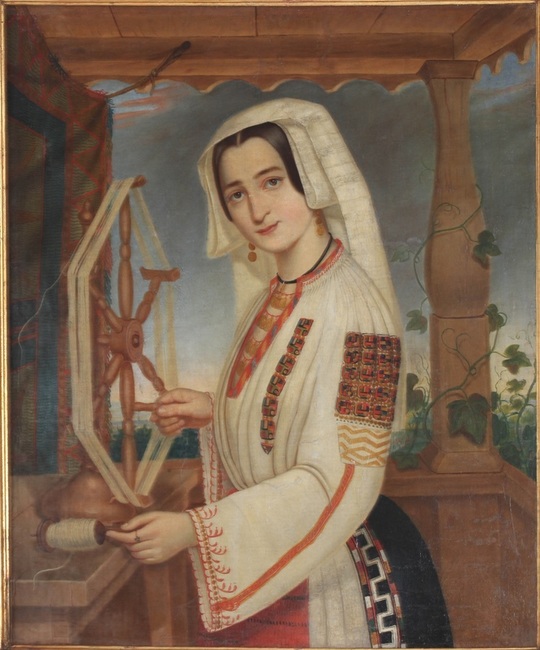Matisse’s masterpiece “La Blouse Roumaine” from the Centre Pompidou’s permanent collection, exhibited in Romania for the first time / PHOTO

By Bucharest Team
- NEWS
- 05 NOV 25
Henri Matisse’s La Blouse Roumaine, an emblematic masterpiece of modern art and part of the permanent collection of the Centre Pompidou in Paris, will leave France for the first time to be shown in the exhibition “Romania – The Identity Representation of the Folk Costume in Art”, opening on November 21 at the National Museum of Art of Romania (MNAR).
The exhibition will feature over 320 works in which the Romanian blouse (ie) appears across diverse mediums — painting, sculpture, graphics, photography, objects, installations, film, music, posters, fashion, stamps, playing cards, vases, banknotes, books, albums, cartoons, and school manuals.
Matisse’s famous painting will serve as a symbolic mirror within the exhibition — one that reflects the consistent national effort of promoting the Romanian identity through the ie, which the artist elevated to a purely aesthetic level. This transformation had a major impact on postwar art, contributing decisively to the emergence of Pop Art strategies.
The Romanian blouse, in Matisse’s interpretation, lies at the origin of the garment’s commercial success in the French and international fashion industries. The exhibition also addresses such uses — including occasional cultural appropriation — to highlight the two main planes through which the ie functions today: as an ideological-identity symbol and as a decorative-commercial object.
From the 16th century through the 19th and 20th centuries — from socialist realism to contemporary art — the Romanian blouse has been a major artistic subject. Through its scope, diversity, and innovative interdisciplinary research, the exhibition creates an unprecedented platform for public access to artistic representations of the ie and Romanian folk costume.
“Romania – The Identity Representation of the Folk Costume in Art” is not a manifesto in favor of any ideology associated with the ie. Rather, it reveals how, over the centuries, a formal, symbolic, decorative, and ideological visual language has developed — one in which the ie and folk costume have played a central role in expressing and shaping national identity.
More than 320 works from MNAR’s own collection, as well as from numerous national and international museums, private collections, and contemporary artists, provide the richest visual and intellectual material ever assembled on this subject. The exhibition’s broad historical and geographical scope contextualizes the Romanian folk costume not only in relation to the traditional attire of other minorities in Romania (Hungarian, German) but also alongside those of neighboring regions — Ukraine, Moldova, and Bulgaria — to highlight similarities, differences, influences, and constants.
The exhibition and its accompanying catalog explore how folk costume — and especially the ie — has been used in art to form, transmit, and enforce national identity narratives from the earliest times to the present.

Depictions of the ie in 16th-century Romanian art are followed by overtly ideological and propagandistic representations from the 19th century, such as portraits of Maria Bibescu by Constantin Lecca and Carol Popp de Szathmari, and of Maria Rosetti — as a symbol of the Romanian homeland — by Constantin Daniel Rosenthal and later by Nicolae Grigorescu and his followers. The exhibition also includes photographic and pictorial campaigns by the Romanian royal family (from Queen Elisabeth to Queen Marie), which used the ie and folk costume for national legitimization; reinterpretations from the interwar period and the Romanian avant-garde; and the ie’s reemergence in socialist realist and communist-era official art. These are contrasted with its reappropriation in the spiritualist and anti-communist neo-Orthodox circles of the 1980s and in today’s critical and subversive art.


Throughout, the exhibition juxtaposes the ie’s symbolic presence with the everyday clothing of different eras — from bourgeois “German” attire to the Frenchified aristocracy’s fashion, military uniforms of the early 20th century, the monotony of communist-era clothing, and the explosion of styles after 1989. Against this backdrop, the ie emerges as a transhistorical and ideological model of identity — one whose benefits, limitations, and risks the exhibition exposes, inviting viewers to attention, reflection, and creativity.
Related events: Throughout the exhibition, MNAR will host symposia, debates, presentations, concerts, and film screenings related to the ie and folk costume.
A dedicated lounge area will allow visitors to embroider, draw, take photos, or join weekend workshops for children and families in a relaxed and creative atmosphere.
The selected works come from MNAR’s collection, Romanian artists and collectors, and 30 partner museums and institutions, including:
Musée national d’art moderne – Centre Pompidou (Paris), Fondation Louis Vuitton (Paris), Galagan Art Museum (Chernihiv, Ukraine – a remarkable collaboration under wartime conditions), National Gallery (Sofia, Bulgaria), National Museum of Art of Moldova (Chișinău), Brukenthal National Museum (Sibiu), Cluj-Napoca Art Museum, Peleș National Museum, Baia Mare Art Center Museum, National Museum of the Romanian Peasant, National Library of Romania, Arad Museum Complex, “Iulian Antonescu” Museum Complex (Bacău), “Moldova” National Museum Complex (Iași), Mureș County Museum, Galați Museum of Visual Art, Criș Country Museum (Oradea), ASTRA National Museum Complex (Sibiu), Brașov Art Museum, “Holy Three Hierarchs” Monastery (Iași), National Museum of Romanian History, Prahova County Art Museum “Ion Ionescu-Quintus”, Piatra-Neamț Art Museum, Memorial of the Victims of Communism and of the Resistance (Sighetu Marmației), Bucharest Municipal Museum, George Oprescu Institute of Art History, Romanian Academy Library – Print Cabinet, National Museum of Contemporary Art (MNAC), National Archives of Romania, and Romfilatelia.
The exhibition is organized in partnership with the Amzei Foundation.
Written by Aura Marinescu | 11.11. 2025, 13:29


























